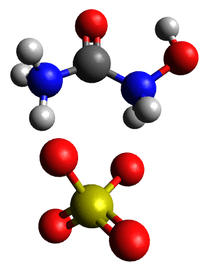Ammonium bituminosulfonate

Ammonium bituminosulfonate or ammonium bituminosulphonate (ichthyol or ichthammol, CAS#8029-68-3 brand names: Albichthyol) is a product of natural origin obtained in the first step by dry distillation of sulfur-rich oil shale. It is used in medicine as a remedy for treating some skin diseases, including eczema and psoriasis. It is commonly used in 10% or 20% concentrate ointment form as a salve. It is sometimes called "black ointment" or "drawing salve". Its dermatological action was promoted by German physician Paul Gerson Unna.
Composition
From elemental analysis, its composition was calculated to be C28H36S5O6(NH4)2. However, as a product of natural origin, it is a mixture of many different compounds.
Chemically, it is a sulfonated shale oil. It can be presented in two forms: pale sulfonated shale oil (PSSO), and dark sulfonated shale oil (DSSO). PSSO, also known as "ichthyol", is incompatible with acids, alkali carbonates or hydrates and alkaloidal salts. DSSO is sometimes called ichthammol. It is a thick reddish brown liquid, possessing a bituminous odor and taste. It is soluble in water and miscible with glycerin, but is nearly insoluble in strong alcohol or concentrated ether. It contains a large percentage of organically combined sulfur.
Usage
Human
Pharmacologically, PSSO and DSSO have anti-inflammatory, bactericidal, and fungicidal properties. It is used to treat eczema, psoriasis, Acne rosacea and acne,[1][2] and it decreases microorganisms in the area surrounding a skin condition. It is commonly used in 10% or 20% concentrate ointment, applied topically.
In otology, a mixture of glycerol and ichthammol (G & I) is used for the topical treatment of ear infections. It is effective against Gram-positive organisms. The anti-inflammatory action is explained by its influence on the formation, secretion, and effect of inflammation mediators.
Veterinary
The European Medicines Agency published a summary report on ichthyol-substances (synonym: bituminosulfonates) during the course of the European Maximum Residue Limits (MRL) procedure[3] in veterinary medicine. The Committee for Medicinal Products for Veterinary Use (CVMP) decided that due to good tolerance and safety, there is no need to establish an MRL for ichthyol-substances. As a result, ichthyol-substances can be applied topically in all mammalian food-producing species without restriction.
References
- ↑ Boyd, Alan S. (July 2010). "Ichthammol revisited". International Journal of Dermatology 49 (7). doi:10.1111/j.1365-4632.2010.04551.x.
- ↑ Warnecke J, Wendt A (February 1998). "Anti-inflammatory action of pale sulfonated shale oil (ICHTHYOL pale) in UVB erythema test". Inflamm. Res. 47 (2): 75–8. doi:10.1007/s000110050282. PMID 9535545.
- ↑ "Veterinary MRL: Report on ICHTHYOL-substances" (pdf). European Medicines Agency. September 2004. Archived from the original on 2006-07-18.
External sources
- Gayko G, Cholcha W, Kietzmann M (October 2000). "[Anti-inflammatory, antibacterial and antimycotic effects of dark sulfonated shale oil (ichthammol)]". Berl. Munch. Tierarztl. Wochenschr. (in German) 113 (10): 368–73. PMID 11084753.
- Cholcha W, Leuschner J, Leuschner F (July 1994). "[The adverse effects of dark sulfonated shale oil following local and systemic administration]". Arzneimittelforschung (in German) 44 (7): 844–9. PMID 7945520.
- Diezel W, Schewe T, Rohde E, Rosenbach T, Czarnetzki BM (December 1992). "[Ammonium bituminosulfonate (Ichthyol). Anti-inflammatory effect and inhibition of the 5-lipoxygenase enzyme]". Hautarzt (in German) 43 (12): 772–4. PMID 1361926.
J Laryngol Otol. 1996 Apr;110(4):319-21. Glycerol and ichthammol: medicinal solution or mythical potion? Nilssen E1, Wormald PJ, Oliver S.